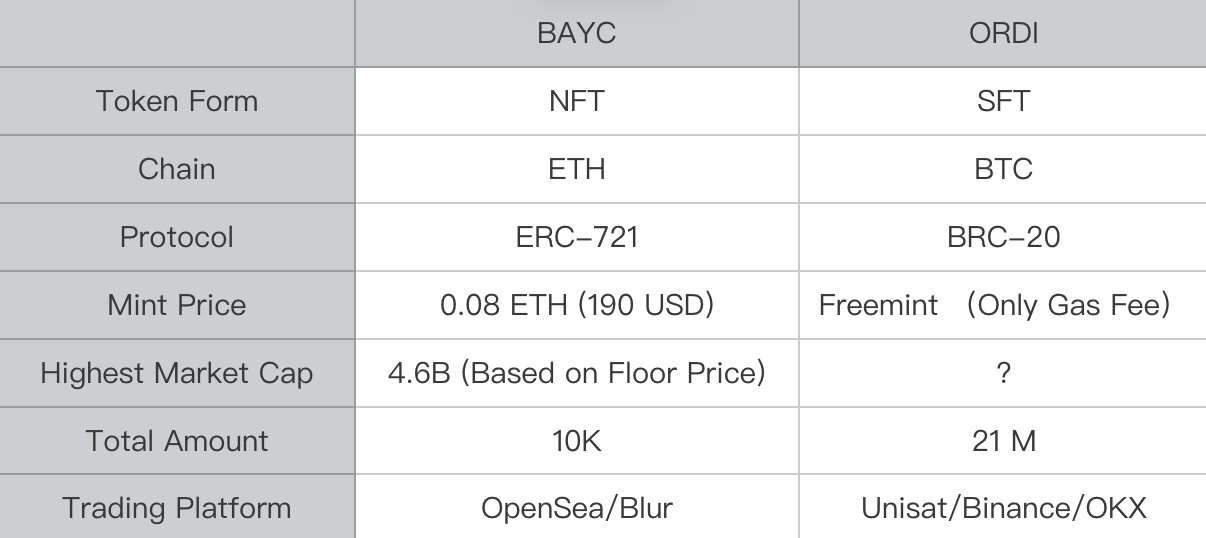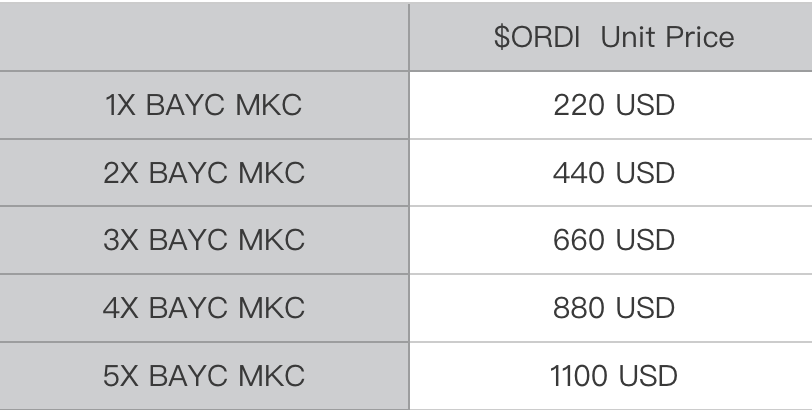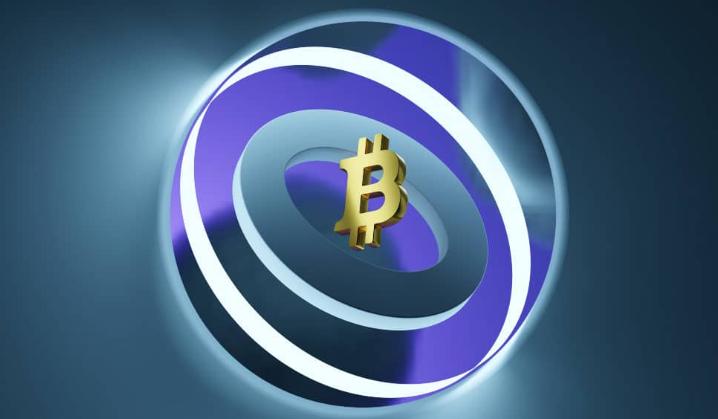Why is it said that the essence of inscriptions is actually SFT?
Written by: CaptainZ
The Summer of Inscriptions
Previously, everyone was guessing which sector the bull market would start from—social, gaming, or ZK? Now there should be no suspense; without a doubt, it is "Inscriptions."
However, how to view "Inscriptions" seems to be a confusing matter. Builders, investors, old OGs, and new retail investors all have different opinions. For a long time, I was indoctrinated with a misconception that "Inscriptions are a new way of asset issuance, similar to the frenzied pump of MEME coins," leading to a misunderstanding until I read the articles by Wang Feng and Joslter, which made me realize the true meaning of Inscriptions.
In this article, I will explain why "the essence of Inscriptions is actually a third type of token form, SFT, distinct from NFT and FT," as well as the ORDI valuation model that arises from this understanding, and finally comment on several common misconceptions.
What is SFT?
For a long time, we have formed several fixed understandings of tokens. Tokens are generally divided into two types: FT and NFT.
Fungible tokens, abbreviated as FT, refer to tokens that are interchangeable. The term "fungible" means "interchangeable." As the name suggests, the characteristic of FT is that any two units of the token are completely identical and can be exchanged for one another, making them "homogeneous" overall.
FT directly corresponds to value units in the real world, such as currency, common stocks, and points, and can be easily understood because they can be calculated through addition and subtraction. Therefore, they appeared first. As early as 2015, when Ethereum was just launched, Vitalik Buterin proposed the idea of implementing FT through smart contracts, and Fabian Vogelsteller proposed the ERC-20 standard in November 2015. After 2016, ERC-20 became the most widely used and well-known token standard, opening up a massive industry worth hundreds of billions of dollars.
Non-fungible tokens, abbreviated as NFT, are the antonym of FT in every aspect. Any two units of FT are identical and interchangeable, while each NFT is unique, one of a kind, irreplaceable, and cannot participate in calculations.
FT represents an abstract quantity unit, while NFT represents specific digital items, such as virtual artworks, domain names, music, game equipment, etc. To express their uniqueness, each NFT has its own unique ID (determined by the contract creation address and serial number) and metadata. The main standard for NFTs is ERC-721, proposed in January 2018 by William Entriken and others.
In the first three years after the birth of NFTs, they can be said to have been a silent supporting role. It wasn't until 2021, with the explosion of crypto art, that the NFT industry suddenly surged. In the first five months of 2022, the new asset scale of NFTs reached $36 billion. Today, NFTs are considered one of the most important infrastructures of Web3 and the metaverse.
SFT, or semi-fungible token, is a new type of token that stands alongside FT and NFT as a third type of universal digital asset. As the name "semi-fungible" implies, it lies between FT and NFT, allowing for both divisible calculations and uniqueness.
It is important to note that because BTC lacks smart contract functionality, previously issued tokens were defined from the perspective of the ETH tech stack. For example, the token standard for FT is ERC20, and for NFT, it is ERC721. So what about SFT? The team led by Meng Yan at Solv Finance proposed ERC3525 in September 2022, which first defined the SFT token standard in the ETH ecosystem.
Although the ERC3525 for the Ethereum ecosystem has been proposed for nearly a year, it has not stirred much in the market. One reason is certainly the bear market, but another reason is that the SFT tokens issued in collaboration with Solv are financial assets of some institutions, or belong to the bond market, aimed at institutional traders and unrelated to ordinary retail investors.
How Does the BTC Chain Issue FT?
Before various smart contract platforms emerged, many people had already experimented with issuing FT and NFT assets on the BTC chain. The most famous among them is the Colored Coin scheme.
Colored Coins refer to a set of technologies that use the Bitcoin system to record the creation, ownership, and transfer of assets other than Bitcoin. They can be used to track digital assets and tangible assets held by third parties and facilitate ownership transactions through Colored Coins. The term "colored" refers to adding specific information to the Bitcoin UTXO to distinguish it from other Bitcoin UTXOs, thus introducing heterogeneity among homogeneous Bitcoins. Through Colored Coin technology, the issued assets possess many characteristics similar to Bitcoin, including preventing double spending, privacy, security, transparency, and censorship resistance, ensuring reliable transactions.
It is worth noting that the protocol defined by Colored Coins is not implemented by general Bitcoin software, so specific software is required to recognize Colored Coin-related transactions. Clearly, Colored Coins only have value within communities that recognize the Colored Coin protocol; otherwise, the heterogeneous Colored Coins will lose their colored attributes and revert to pure satoshis. On one hand, Colored Coins recognized by small-scale communities can leverage many advantages of Bitcoin for asset issuance and circulation; on the other hand, it is nearly impossible for the Colored Coin protocol to merge into the maximum consensus of Bitcoin-Core software through a soft fork.
The Mastercoin project conducted an initial token sale in 2013 (what we now call an ICO or Initial Coin Offering) and successfully raised millions of dollars, which is considered the first ICO in history. The most famous application of Mastercoin is Tether (USDT), which was initially issued on the Omni Layer as the most well-known fiat stablecoin.
The biggest difference from Colored Coins is that Mastercoin only publishes various types of transaction behaviors on-chain and does not record relevant asset information. In Mastercoin nodes, a state model database is maintained off-chain by scanning Bitcoin blocks. Compared to Colored Coins, the logic it can accomplish is more complex. Additionally, since it does not record state and verification on-chain, its transactions do not require continuity (continuous coloring). However, to implement Mastercoin's complex logic, users need to trust the state in the off-chain database of nodes or allow Omni Layer nodes to perform verification.
How Does the BTC Chain Issue NFT?
The above two protocols mainly issue FT assets based on the BTC chain. For NFT assets, we must mention Counterparty.
Counterparty was launched in January 2014, initially as a platform for FT financial asset tokens, but quickly became one of the earliest sources of NFTs, such as Spells of Genesis, Rare Pepes, and Sarutobi Island. In Counterparty, you must give up a special Counterparty transaction to transfer the ownership of a token. The Counterparty node will parse the data of this transaction off-chain and then update a ledger/database stored in the Counterparty node. This is accomplished using OP_RETURN, a method for storing arbitrary data in Bitcoin transactions (thus allowing data to be stored in the Bitcoin blockchain).
The true explosion of Counterparty occurred after the launch of the 1774 NFTs in the Pepe the Frog series. Collectors used Counterparty wallets to store these NFTs, while Counterparty used OPRETURN outputs to anchor the indexes of these NFTs to the Bitcoin blockchain. The data size limit for OPRETURN outputs is 80 bytes, which is enough for Counterparty to include the description, name, and quantity of the NFT (but for ordinal NFTs, the only limit on data size is the size limit of Bitcoin blocks, which we will discuss in detail later).
In addition to using OP_RETURN, BTC itself has also been evolving. The technological changes brought by the SegWit (2017) and Taproot (2021) updates have paved the way for the introduction of Ordinals.
The Ordinals protocol was essentially created for NFTs existing in the Bitcoin ecosystem. In January 2023, Casey Rodarmor introduced Ordinals, describing them as electronic artworks. Its principle is also quite simple. Satoshi (sat) is the smallest unit of Bitcoin, named after Bitcoin's creator, Satoshi Nakamoto. Since one Bitcoin has 100 million sats, each sat is worth 0.00000001 BTC. When all 21 million Bitcoins are mined, there will be 21 trillion sats. Typically, each sat is indistinguishable from other sats. Because each sat is equivalent to another sat—and can be exchanged at equal value—they are considered interchangeable.
The Ordinals protocol is a system that can distinguish and track individual sats. When a new Bitcoin block is mined and new Bitcoins are created as mining rewards, the protocol assigns a unique number to each Bitcoin based on its mining time, with smaller numbers corresponding to earlier sats.
When transactions occur, the Ordinals protocol tracks each transaction in subsequent transactions in a "first in, first out" manner. The numbering of sats is called Ordinals because the identification and tracking mechanism depend on the chronological order of creation and transactions. Once a sat is identified by the Ordinals protocol, users can inscribe any data onto the sat to give it unique characteristics, defined as crypto art. This functionality was only made possible after the SegWit (2017) and Taproot (2021) upgrades to Bitcoin Core.
When an Ordinal is inscribed, Inscriptions are bound to a special type of Taproot code. Although this method imposes more restrictions on storing arbitrary data on Bitcoin, it allows Inscriptions to contain more and larger data. Creating Inscriptions and interacting with them requires running a full Bitcoin node and a special wallet that supports Ordinals. Ultimately, we have:
Ordinals + Inscriptions = NFTs
The Ordinals theory can be imagined as a way to observe the Bitcoin blockchain through special goggles, allowing users to create, view, and track additional information associated with each sat.
So the final question arises: how do we issue SFT assets based on the BTC chain?
The Essence of Inscriptions Tokens is SFT
The BTC chain lacks smart contract functionality, so any asset issuance must use scripts like OP_RETURN or TAPROOT. Therefore, theoretically, there are two ways to issue SFT:
- "Add" some form of "uniqueness" on top of FT tokens;
- "Add" some form of "homogeneity" on top of NFT tokens;
Thus, the BRC-20 token was born, utilizing the second method. As mentioned in the previous chapter, "users can inscribe any data onto sats to give them unique characteristics," so inscribing a piece of text makes it a text NFT (corresponding to Loot on Ethereum), inscribing an image makes it an image NFT (corresponding to PFP on Ethereum), and inscribing a piece of music makes it an audio NFT. But what if we inscribe a piece of code, and this code is for "issuing FT fungible tokens"?
BRC-20 achieves this by using the Ordinals protocol to set inscriptions as JSON data format to deploy token contracts, mint, and transfer tokens. The JSON contains executable code snippets that can be implemented on the Bitcoin network, describing various attributes of the token, such as its supply, maximum minting capacity, and unique code.
Thus, we see what seems like a strange phenomenon: when inscribing, we inscribe "one," which is 100% an NFT, while "one" can also be split, allowing the homogeneous tokens to be distributed one by one. This is somewhat similar to the concept of "wholesale and retail" in the real world. It is no wonder that some people believe "inscriptions are splittable NFTs," but this combination of NFT and FT attributes is precisely what we referred to earlier as SFT!
Domo inadvertently achieved the issuance of SFT assets through this seemingly ancestral technical method without using smart contracts, which is truly a remarkable feat!
How Does the ETH Chain Issue SFT?
We briefly discussed how non-smart contract public chains (BTC chain) issue FT and NFT. For smart contract platforms like Ethereum, everyone is quite familiar with how to issue FT and NFT, which are the common ERC20 and ERC721 tokens. So the question arises: how do we issue SFT on the ETH chain? There are two token standards to choose from: ERC-1155 and ERC-2535.
ERC-1155 is a multi-token standard. Based on its essence, we prefer to call it a multi-instance NFT standard. It is suitable for a relatively narrow application scenario, where the same NFT has multiple identical instances. Note that they must be completely identical; any difference disqualifies them as the same class.
ERC-3525 is the semi-fungible token standard, a universal standard with a very broad application scope. It can recognize multiple similar but not identical tokens as "similar" and then allow special operations such as mutual transfers among similar tokens. Effectively, it allows for mathematical operations such as merging, splitting, and fragmentation among similar tokens.
The main difference between the two lies in the definition of "similar."
- ERC-1155 requires that similar objects must be completely identical; even the slightest difference disqualifies them as similar;
- ERC-3525 allows for seeking commonality while preserving differences, where the key properties are the same, but non-key properties can differ;
For issuing SFT tokens with only MEME attributes, ERC-1155 is sufficient. For assets with more financial attributes, ERC-3525 is more appropriate. Unfortunately, whether it is 1155 or 3525, there has been no large-scale use in the Ethereum ecosystem; only a few institutional users have issued a small number of debt-related SFTs.
Why Did Inscriptions Succeed?
Inscriptions is a broad and generalized term, originally defined as "a piece of content inscribed on-chain." Looking back at history, we can clearly see that the NFT version of inscriptions was not considered successful, and the waves it created were minimal. The focus of discussion at that time was whether it was worthwhile to issue NFTs based on the BTC chain after the existing smart contract version of NFTs (ERC-721).
Following the concept of fully on-chain games, we can introduce the concept of fully on-chain NFTs. It is well known that NFTs based on Ethereum's ERC-721 store only the address of the image or content in metadata. If the content is placed on traditional cloud servers, this address is a web link; if the content is stored in distributed storage, this address is a hash value. No wonder Musk has long ridiculed NFTs by saying, "At least encode the small images onto the blockchain." Therefore, we say that NFTs on Ethereum are "off-chain stored content, on-chain stored addresses." If centralized storage servers or distributed storage servers disappear, the NFTs will also vanish.
In contrast, the NFT version of inscriptions is a true fully on-chain NFT, with content directly stored in the BTC chain space, merely using ordered sats to point to the content. This is indeed an advantage, but this advantage is not enough to persuade everyone. So before March, Ordinals NFTs were lukewarm, merely a small market for images, until the emergence of BRC-20.
I believe the success of BRC-20 can be attributed to the following reasons:
BRC-20 implemented the issuance of SFT assets on a non-smart contract public chain using a clumsy method. SFT tokens are a new asset form distinct from FT and NFT, which is the most essential reason for its success (Ordinals NFTs were not successful in the early stages).
BRC-20 adopted a fair sale principle, distinguishing it from the "VC model" in the Ethereum ecosystem, allowing it to open the market through a broader wealth effect in a short time, triggering FOMO (a stark contrast is Solv Finance).
The leading SFT token ORDI has experimental MEME coin attributes, and this token without a valuation model has brought more imagination (or consensus value).
SFT combines the dual advantages of FT and NFT, allowing it to directly utilize existing FT and NFT infrastructure. Thus, we find that inscriptions tokens can be traded on NFT marketplaces like OpenSea, as well as centralized exchanges like Binance and OKX, and even on DEXs like Uniswap. In the initial stage, when treated as NFTs, they exhibit low liquidity characteristics, making price increases (pumps) easier. After being listed on centralized exchanges, there is a massive influx of liquidity to support them, reaping all the benefits.
It has absorbed the overflow funds from the BTC ecosystem. For a long time, BTC holders wanting to participate in DeFi, NFTs, gaming, and social activities on-chain could only do so through cross-chain operations. Now, there are finally native BTC products to engage with.
ORDI Valuation
ORDI is the first SFT token in the BTC ecosystem and has MEME attributes, so it does not have an intrinsic valuation model. In other words, the only limit is your imagination. However, we can still make an estimate by reviewing the leading NFT market player BAYC.

BAYC has always been the leading NFT token project, similar to a fair sale (low-price mint), then skyrocketing thousands of times, reaching a peak market value of about $4.6 billion in May 2022.
As the first token of BRC-20, ORDI can be minted for free with just a small gas fee, then skyrocketing thousands of times, currently stabilizing at $70 (as of December 2023). We assume that ORDI continues to maintain its leading position as an SFT token in the future, then at the peak of the bull market, it could at least align with BAYC's market value, with a unit price of $220. However, since ORDI can be traded on centralized exchanges, its liquidity is far higher than that of NFTs like BAYC (many players who purely speculate on coins will only trade on centralized exchanges and will not use wallets). Therefore, a total market value reaching 3-5 times that of BAYC is also acceptable, leading us to the following table:

This horizontal comparison valuation method is certainly quite rough, so just take a look; after all, when emotions come, you dictate the price.
Several Misconceptions
Blind men touching an elephant; when a new thing appears with many new features, each person may only see a leg of the elephant or its long trunk, but do not think that is the entirety of the elephant. In the past six months, I have seen many people's explanations, and many of their views have led my understanding astray. It wasn't until I read the articles by Wang Feng and Joslter that I truly understood the essence of inscriptions.
1. Inscriptions are a new way of token distribution
This understanding is completely incorrect. The so-called "inscription" is merely uploading a piece of content to the blockchain space. This method of inscription has existed for years, and even a few mining pools have offered related inscription services. Moreover, when Ordinals first inscribed NFTs, it did not gain traction; it was the shift to inscribing JSON format fungible tokens that became popular. Therefore, the correct understanding should be: inscriptions tokens are a new type of token form, SFT.
2. Inscriptions are just a capital pump like MEME
This view reflects my previous understanding, which is partly right and partly wrong, as the bull and bear cycles of the entire web3 are too obvious. Any sector, including previous DeFi and NFT, follows a "narrative + pump + dump" cycle over a four-year period, and ORDI indeed has MEME coin attributes. However, this understanding only sees the first leg of the elephant and does not recognize the essence that "inscriptions tokens are a new token form, SFT," which is a generalization.
3. Inscriptions are a backward technology, a regression
This view is half correct and half wrong. Among current public chains, the BTC chain without smart contracts and the ETH chain with smart contracts should not be conflated. For the BTC chain, the only way to issue SFT seems to be through BRC-20 or variants of similar protocols. However, for smart contract public chains, issuing SFT in the form of inscriptions is indeed a regression technically, as there are better ERC-1155 and ERC-3525 standards, which can only be seen as speculative hype.
4. Inscriptions are a counterattack from the BTC ecosystem against the ETH ecosystem
This view is half correct and half wrong. The ETH ecosystem already has SFT standards, but they have not developed because only VCs and institutions participated, without benefiting retail investors. Retail investors can only choose BRC-20 protocol tokens issued through fair sales in the BTC ecosystem, which is a resistance against VCs and also a resistance against the "orthodoxy" of Ethereum. However, this "resistance" is merely the second leg of the elephant, not the elephant itself, so do not generalize.
5. Inscriptions are like carving flowers on gold
This view is also partly right and partly wrong. If BTC is compared to digital gold, this metaphor is very vivid, but it still overlooks the essence that inscriptions tokens are a new asset form, SFT, which is a generalization.
Through the above discussion, we can see that the essence of the inscriptions sector is an explosion of the new token form SFT. For non-smart contract public chains, SFT can only be issued through BRC-20 as a "memo field." For smart contract public chains, there are two ways: one is to call the VM to issue via smart contracts, and the other is to issue via "memo field" without calling the VM. In the next article, we will explore the two evolutionary directions of "inscriptions tokens": recursive inscriptions and smart inscriptions.










